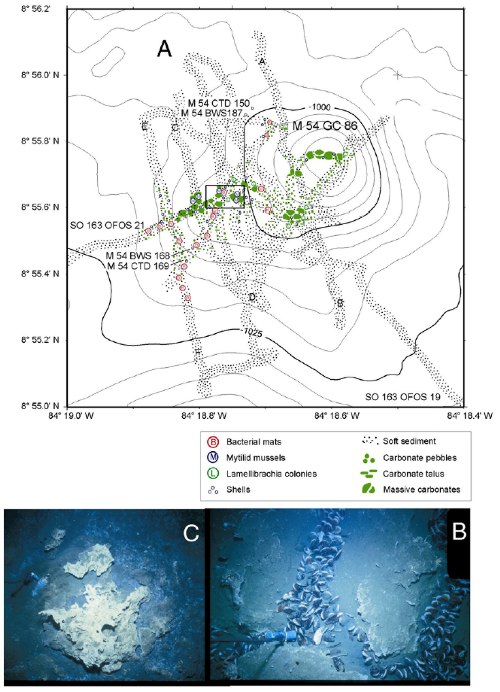 Web Content Display Web Content Display
Overview Theme B6
Active fluid venting sites characterized by living chemosynthetic communities and extensive carbonate precipitates are widespread features along the Costa Rica margin and in other subduction systems. During the first phase of SFB 574 about 200 such vent sites were discovered and >500 authigenic carbonates sampled. Several types of carbonate lithologies were identified: Chemoherm and seepage-associated crusts, gas hydrate-associated carbonates, calcareous concretions and dolostones. Stable C- and O-isotopes reveal that all types are depleted in d13C and enriched in d18O. The C-source in all cases is either thermogenic or biogenic methane or a mixture thereof. All samples have equilibrium d18O-signatures heavier than todayâ€TMs ocean ranging from +1 ‰ SMOW (e.g. cement of chemoherm and seepage-associated carbonates) to +4 ‰ SMOW (e.g. filling of a bioturbation tube; buried fluid channels). This indicates precipitation from fluids which contain deeply sourced clay-dehydration water or gas hydrate water; both sources have considerably enriched d18O-signatures.
Samples of different relative ages display trends indicating that the equilibrium d18O of the precipitating fluid is getting "lighter" with time. Few absolute ages based on U-/Th-disequilibrium and/or the isochron dating confirm this trend. Systematic differences are also evident in trace element composition between buried concretions and seepage associated crusts; whereby the latter have the lowest trace element concentrations with REE pattern close to that of seawater. The new objectives of TP-B4 are several fold: (1) expand the approach of a detailed interpretation of the authigenic carbonates based on C- and O-isotopes; (2) emphasize reconstruction of the composition and source of the precipitating fluid; whereby the trace element and REE make-up are essential parameters; this objective includes development of isolating pure authigenic phases in order to reduce the interference of insoluble residues; (3) penetrate and obtain samples from carbonate caps of the mounds by drilling in order to obtain long time-integrated archives; this objective includes field deployments on board RV METEOR of the ROV- and PROD-systems as approved for 2005 as well as development of absolute dating techniques for increased sample throughput in order to establish budgets and inventories of carbon residing in the authigenic phases; (4) ascertain active venting manifestations off the Chilean margin; this objective relies heavily on high-resolution multi-beam, side scan-sonar and OFOS-surveys jointly conducted with the subprojects A-1 and B-2 complemented by the proven TV-guided sampling techniques. |
 Events Events
Kieler Wissenschaftler fühlen den 'Puls der Erde' Wie funktioniert die Recyclingmaschine der Erde?Nach elf Jahren endet der Kieler Sonderforschungsbereich 574 zu Subduktionszonen Final colloquium of SFB 574 Teilprojekt ÖffentlichkeitsarbeitMEERESFORSCHUNG FÜR MICH UND DICH |
|
©SFB574 // Wischhofstrasse 1-3 // D-24148 Kiel // T. +49 (0)431 600 1413 // elange [AT] geomar.de






